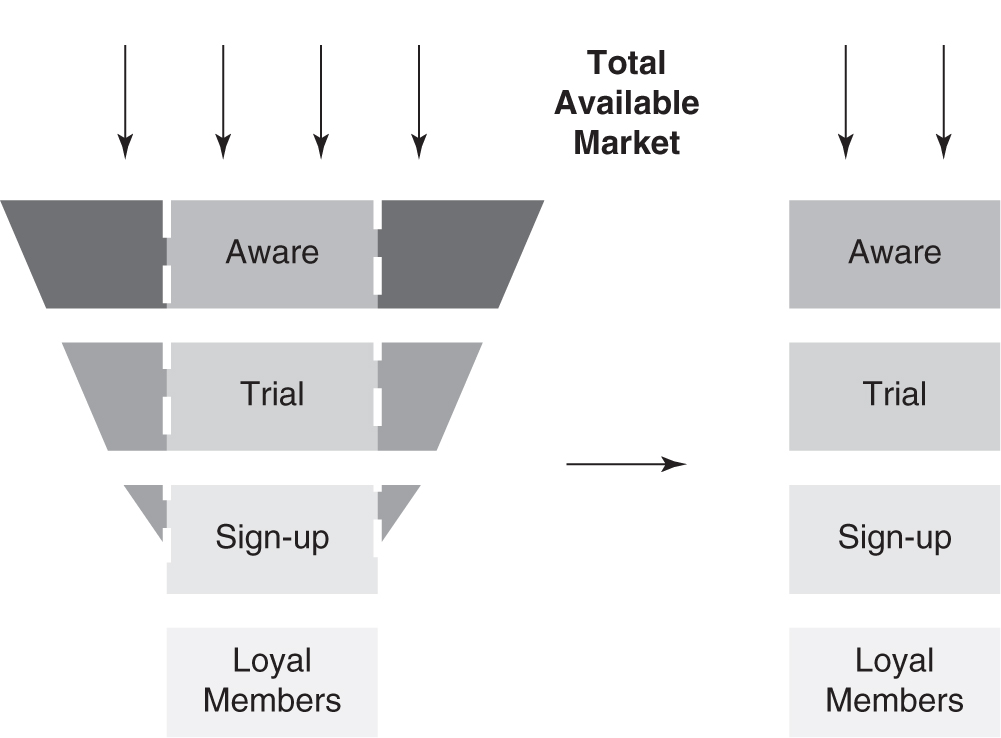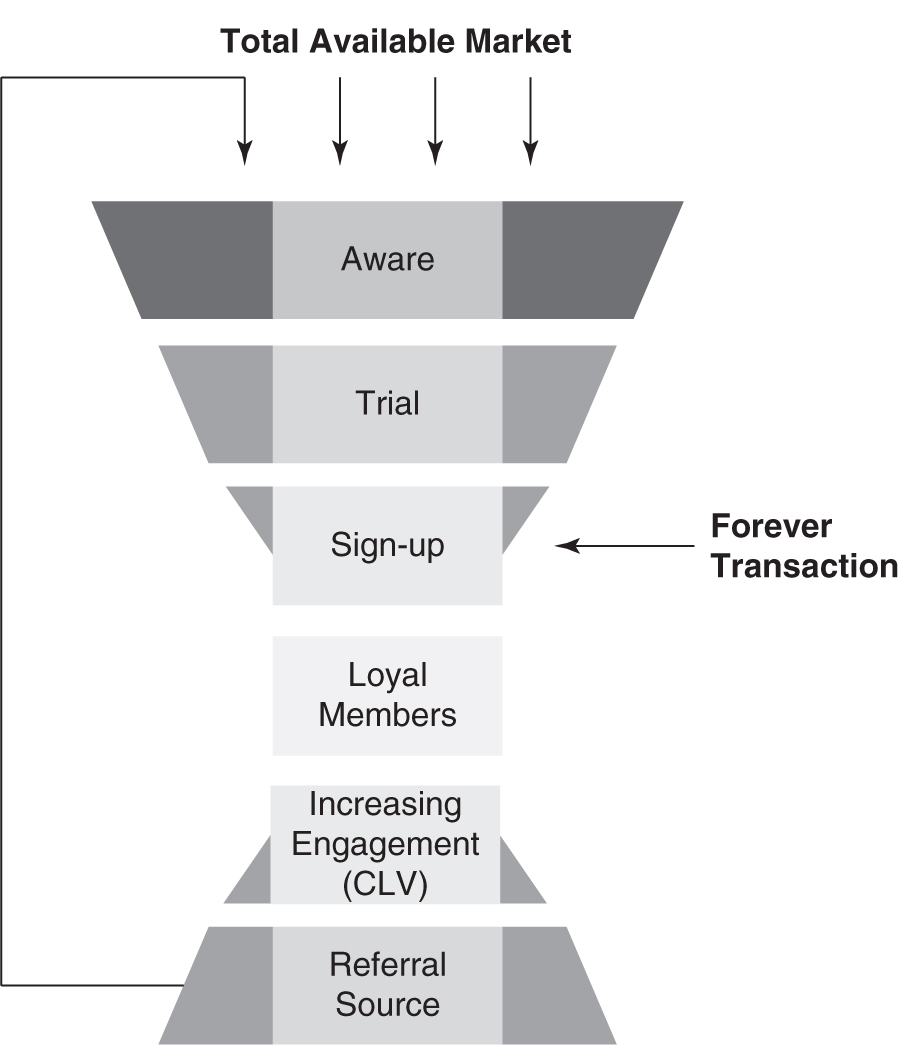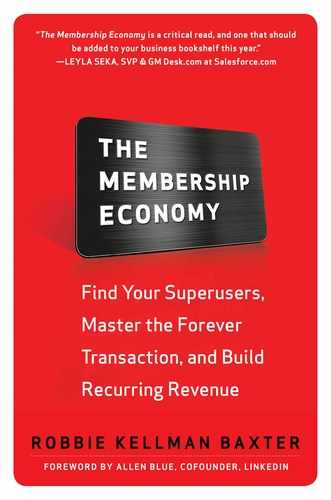Build an Effective Acquisition Funnel from the Bottom Up |
Suppose I told you I didn’t like McDonald’s because my husband and I went there for our anniversary and were disappointed by the ambiance and lack of caviar and champagne. You might say, “Robbie, don’t you know that McDonald’s is not designed for wedding anniversaries? It’s designed to be quick, cheap, and consistent.”
McDonald’s has done a great job of letting people know what its brand represents. More than that, it has done a great job of building a consistent experience. You can walk into any McDonald’s in the world and know the fries will taste like McDonald’s fries and the Big Mac will taste like a McDonald’s Big Mac.
What’s important about this clear message is that you don’t have a lot of people who have experiences that were inconsistent with their expectations who then bad-mouth the product. There is some waste at the top of the McDonald’s “sales funnel,” in that many people who are familiar with the brand and ads would never eat there, but I think it’s safe to say that few people are surprised by what they find when they walk into a McDonald’s restaurant.
In this chapter, we focus on the funnel. I explain what a funnel is and how you can use a funnel or alternative structure to attract the right people, engage them, and even motivate them to strengthen the funnel by attracting and retaining others. The best Membership Economy models go beyond the transaction, tracking behaviors including sign-ups for additional services and levels of membership. The funnel can even track referrals made by existing members that lead to new members.
The Steps in a Typical Sales Acquisition Funnel
Figure 5.1 shows a typical sales acquisition funnel. Tracking the steps in your organization’s funnel is important because it can provide insight into how you win (and don’t win) new members.

Figure 5.1 Sales acquisition funnel.
At the top are people who are aware of the brand but haven’t engaged with it yet. At the bottom are the most loyal customers. Different channels such as partnerships, ad campaigns, and events, should feed the funnel. A fraction of the people who are aware of the offering will want to learn more. Some of those people will try it. And some of the people who try it will become members. The funnel tracks individuals’ progression from the moment they learn about the membership until the moment they become a member. In the middle of the funnel are prospects who have engaged with your brand but haven’t become members yet. Maybe they have attended an event your organization has hosted, or they’ve read your newsletter. At this phase what’s important is building the trust required for a formal commitment. At the bottom of the funnel are customers and their ongoing, and hopefully increasing, engagement with the organization.
Many companies are content with a wide top and a narrow bottom, the idea being that it’s always good for more people to engage with you and try your product. However, funnels involve a lot of waste. Many of the people at the top who interact with your brand will never become customers and maybe should never become customers.
An alternative to an acquisition funnel is the chute, shown in Figure 5.2. A chute is the same width at the top and the bottom, and things move quickly from the top to the bottom of a chute. By narrowing the funnel—that is, by focusing awareness at the top and maximizing the number of prospects that stay in the funnel at each stage—an organization can have more of a chute.

Figure 5.2 The funnel and chute.
An example of an organization that goes back and forth between funnel and chute is American Express. Initially, it started with a single card—the green one—and blanketed the marketplace with campaigns to build awareness. As the company grew more sophisticated about who actually became loyal members, it refined its awareness campaigns and also introduced new products—gold, platinum, blue, black, and most recently two new debit cards targeting people who have no existing relationship with banks, such as recent immigrants and lower income groups. As Amex introduces these new offerings and focused campaigns, they are creating multiple chutes from a single funnel.
Targeted marketing is even more important for subscription or membership businesses than for transactional organizations, because the membership organization makes a profit only if the member stays for an extended duration. So if a recurring revenue business pays for a prospect to have a free trial and the prospect is not the kind of person who would benefit from the membership, that money is wasted and the person will be disappointed with the effort.
Step 1a: Start at the Bottom of the Funnel
All efforts need to start at the bottom of the funnel, thus ensuring that there is alignment between the actual benefits provided and the target member’s needs. These benefits need to align with the organization’s mission, in fact, to deliver on that promise to new members. To do that, you need to know exactly who your target member is. (Do you?) You also need to be 100 percent confident that your best salesperson could convert an ideal prospect during a friendly conversation on a 45-minute plane flight. In other words, if given enough time to explain the value proposition in a customized way, the prospect would buy it.
To get value out of the funnel, first outline the steps from awareness to sign-up. In many organizations, these steps are awareness, engagement (when the prospect gives the organization permission to contact him), trial, and membership. Some funnels include postmembership sign-up events like renewal and up-selling. The important thing is to have clear definitions of each segment and then to track the ratios.
There are several ratios to track. You want to track the relationship between the number of people who are aware of your organization and the ones who engage. Then you want to track the percentage of engaged people who convert into members over a certain period of time. You probably want to track these things in a granular way—by specific campaign or channel—but as a starting point, you just want to be aware of how many people make it through each level of the funnel. If people aren’t converting from one level to the next, it’s like you have a hole in your funnel, and that is a waste.
Step 1b: Look Beyond the Bottom of the Funnel—Engage and Retain
Additionally, you want to be sure that members will stay once they join. This can be tricky if you are just starting out, but for established businesses, waiting to see if members stay at least for the first 30 days (long enough to establish a habit) is worthwhile. If the member/benefit alignment is strong, they will stay. You want to check because sometimes people sign up out of optimism or aspiration and then realize that they don’t get any value from the membership. These people will cancel, if not now, then soon. When people cancel because they realize they aren’t getting value in something they just signed up for, you can also expect that they will feel angry or betrayed. And this can convert to bad word of mouth or media publicity.
Sometimes the funnel even tracks what happens after the prospect becomes a member. By measuring how new members behave, whether they refer friends and what distinguishes the loyal ones from the ones who leave, the funnel can have greater value for membership-oriented organizations. The shape of this “funnel” resembles an hourglass (shown in Figure 5.3), and goes “past” the bottom of the funnel, widening to emphasize the importance of the transaction. With this funnel, you can see the impact of each individual new member in driving significant and increasing revenue after the initial transaction. If you use an hourglass funnel, you become even more aware of how important it is to retain the customers you have acquired.

Figure 5.3 The hourglass funnel.
This is why the first step, the member/benefit alignment, is critical. If you are not certain a prospect would love the offering if he or she knew about it, there is no point in investing in anything other than fixing the offer and figuring out whom to target. Maybe you have the wrong target. Maybe the offer isn’t complete.
In any case, why invest in acquiring a member who’s going to leave quickly and cost you money? Membership/benefit alignment is the most important thing, but many organizations still ignore it and rush ahead to build acquisition programs.
Step 2: Refine the Message
You can’t have your CEO personally deliver every pitch, so it’s important to figure out how to crystallize your message so that it can be delivered without him or her. What are the key things that prospects need to know in order to engage with your organization? How can you develop the words and pictures that convey these things without an evangelist present?
You can test your message through any of your channels—on the website, through telemarketing, or in a live pitch by a telemarketer or salesperson. Testing is critical. This means trying different options in small quantities and comparing the results until you craft one that seems to work consistently.
Again, remember that you don’t want to invest heavily in ads or websites or sales training for your team until you know you have the right message and offering. It is worth being patient, experimental, and flexible.
Step 3: Select Channels and Develop Programs
Now that you have a strong message, you can determine the types of campaigns to run. You want to reach prospects at a time when they’re willing to buy. It doesn’t matter how good your pitch is or how much I’ll need a parka next winter, I’m just not going to buy one while I’m sitting on the beach in July. You need to think about the right channel and the right timing to reach your target buyers. The good thing about channels is that they are often easy to test in small iterations, so you can figure this out without big investments.
If you want to have a freemium model and rely on viral buzz, maybe you want to prioritize getting as many people as possible onto free membership to give people a chance to engage on an ongoing basis with your offerings and members. Or maybe you think you’d get better results by advertising with key words? Or through partner relationships? There are dozens of options to bring people into your funnel and nurture them until they’re ready to spend money with you. What works, however, will change over time, so continue testing and measuring, even if your current approach is working.
But remember to start at the bottom of the funnel and don’t spend on acquisition until you know that prospects are likely to join, and, more importantly, to stay!
Step 4: Rinse and Repeat—Constantly
This process is not a one-time thing. It should be an ongoing activity for a membership organization because it can tell you where the challenges are. If retention is strong but acquisition is dropping, it could mean that your message is no longer compelling enough to win, even if your members demonstrate loyalty (which can be hard to distinguish from inertia). Or if you find that your retention rate is dropping, it may be there’s a natural cliff where people no longer see value. Perhaps members’ needs are changing.
I suggest that my clients (not just marketers, but the entire leadership team) monitor the funnel and review the metrics at weekly team meetings in order to identify changes in the ratios and also to work to improve each of these. Any time you add a new program or channel, you need to track how the metrics from that activity stack up against other programs and how you can optimize them for best results.
And remember, start at the bottom of the funnel and work your way to the top. It’s a more cost-effective approach.
Continuously Improve Your Funnel—You Don’t Want a Sieve
Your acquisition funnel is more than a metaphor for attracting and recruiting members. It can also tell you:
![]() Which channels and programs are driving awareness, acquisition, and resulting in loyal members.
Which channels and programs are driving awareness, acquisition, and resulting in loyal members.
![]() Where prospects are losing interest and disengaging from the acquisition process.
Where prospects are losing interest and disengaging from the acquisition process.
![]() How well your sign-up flow works.
How well your sign-up flow works.
![]() Where your “best” members come from.
Where your “best” members come from.
Over time, you want to improve the conversion ratios from awareness to engagement to trial to sign-up. You can use the funnel to identify the biggest worries. For example, if you are bringing in lots of trials, but no one converts, you can focus on this step and fix it. First, develop hypotheses. Maybe people aren’t fully utilizing the trial, so they don’t see the benefits before the trial ends. Maybe they like the trial but find the membership terms themselves (price, duration) too high. Maybe, like one customer of mine, they didn’t even realize they had signed up for the trial (evidenced by the fact that they never took advantage of the trial at all). Test these hypotheses by changing the pricing on a limited percentage of trials or by surveying the trial enrollees.
If you are investing in a significant amount of awareness activities, like email, events, tweets, and advertising, and you have a lot of people engaging with your content and members, but no one signs up for a trial, maybe they don’t need your offering, but like your emails, free events, and website content—in other words, you are marketing to the wrong people.
Figure out where the problems are, so you can improve the funnel.
Companies that are disciplined in their approach to innovation get a much better payoff than the ones that are eager to “just try something.” An example of an organization that invested in innovation before moving up the funnel is Weight Watchers Online. It focused on the bottom of the funnel, getting the experience and the benefits right before marketing to all prospects. Even though Weight Watchers had a proven and successful offline model, the whole model had to be rethought for a digital experience, and the company took its time to build a model that was quite different.
Weight Watchers Online is the exception, however. More than ever, companies are eager to start firing before they aim because they believe that they can just see what sticks. Many companies suffer from what I call the “Steve Jobs meets Field of Dreams” problem.
Jobs was famous for pointing out that sometimes his customers couldn’t provide good feedback about what they wanted, because they didn’t know what they wanted until they’d seen it. Ten years ago, who knew they needed an iPhone? Who knew they needed a tablet computer? The implication for many misguided entrepreneurs is that they know better than consumers what the consumers will want and “if we build it, they will come.” Sadly, 99 percent of the time, this approach fails miserably. Thinking that you can be the next Steve Jobs and simply “know” what customers need is like saying you’re going to drop out of college and start a company because that’s what Steve Jobs did. Just because he did it doesn’t mean it’s going to work for everyone.
Remember
You should build an effective acquisition funnel—or chute—from the bottom up, constantly refine the message, select the marketing channels to reach the most likely prospects at the time they are most likely to be interested in what you have to offer, and reiterate with discipline. Once you have an efficient funnel, you want to bring members on board by removing friction and delivering immediate value as well as rewarding desired behaviors that drive member success—the subject of the next chapter.

